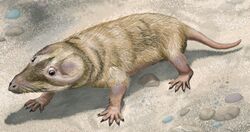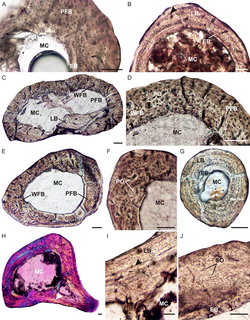Biology:Brasilitherium
| Brasilitherium | |
|---|---|

| |
| Life restoration of Brasilitherium riograndensis | |
| Scientific classification | |
| Domain: | Eukaryota |
| Kingdom: | Animalia |
| Phylum: | Chordata |
| Clade: | Synapsida |
| Clade: | Therapsida |
| Clade: | Cynodontia |
| Family: | †Brasilodontidae |
| Genus: | †Brasilitherium Martinelli & Schultz 2003 |
| Type species | |
| †Brasilitherium riograndensis Martinelli & Schultz 2003
| |
Brasilitherium, from "Brazil" and therium (Greek for "beast"), thus meaning "Brazilian beast", is an extinct genus of cynodonts that lived during the Middle to Late Triassic in what is now Brazil .[1] It was approximately 12 centimetres (4.7 in) long and weighed around 20 grams (0.044 lb). It probably fed on insects. Brasilitherium was found in the Candelária Formation of the Paraná Basin in southeastern Brazil.[2][3] Brasilitherium represents a transition between advanced cynodonts and mammals, having features of both and having early evolution of certain mammalian features, such as hearing and a nasal cavity.[4]
Paleoenvironment
The discovery was part of the Caturrita Formation, where the rock was made up of two different layers, the lower layers being sandstone and upper layers being mudstone.[1] This specific taxon was found in the fine sandstone layer in the middle.[1] The fossils were found in outcrops, and due to the different layers, it is suggested that there was a river, and this area experienced both gravitational flows as well as peak flows.[1] Gravitational flow would be a type of flow due to gravity, where as peak flows would be due to specific events that experienced a high amount of flow causing an event.
Discovery
Brasilitherium was discovered in Rio Grande do Sul in Southern Brazil, work initiated by the Museu de Ciencias Naturals of the Fundacao Zoobotanica of Porto Alegre.[1] Brasilitherium is part of the family Brasilodontidae, and was found in the middle to late triassic.[5] The family of Brasilodontidae was found in Argentina, India, and Brazil, where Brasilitherium was found.[5] Brasilitherium is thought to be a transitional species between cynodonts and the earliest mammals.[4]
Description and paleobiology
Skull
The skull of the Brasilitherium is about 21 millimetres (0.83 in) in length.[1] The dentary bone in the skull is more slender than in previous ancestors, as well as a slightly smaller skull in general.[1] The genus Brasilodon is different from Brasilitherium due to the lower post canines as well as the pre orbital.[1]
Although more studies and more fossils are needed to truly confirm, paleontologists seem to believe that Brasilodon and Brasilitherium are not sister groups and that Brasilitherium is more closely related to mammaliaformes.[6] The lower jaw is articulated to the skull, which is between the squamosal and the dentary which isn't seen in other cyandonts.[4] When looking the jaw of Brasilitherium, one could say that it is closely related to Thrinaxodon, but paleontologists have concluded that they are not closely related, but simply have convergent evolution.[5]
The skull shows quadrangular upper post canines and asymmetrical lower post canines.[1] Post-canines are constantly getting replaced in this taxon and they are replaced in an alternate sequence, meaning they are not getting replaced next to each other at the same time.[7] Brasilitherium's post canine teeth also have more that one replacement which is something they keep from their cynodont ancestors.[7] The upper incisors are also ventrally directed.[1]
In terms of comparing Brasilitherium to Brasilodon, the interpterygoid vacuity is 1/6 the skull length in Brasilodon and 1/8 the skull length in Brasilitherium. [4] From the skull paleontologists found that the wings of the vomer and posterior part of the nasal cavity forms the primary mouth roof, and an elongated secondary palate also forms.[8] Origin of the nasal capsule is hard to place on a phylogony due to late ossification, therefore it was most likely cartilagenous in this taxon.[9]
Other features

Brasilitherium is a transitional taxon that sets the stage for development of different critical features. Brasilitherium has specialized their basicranium which allows them to start specializing in the middle ear and hearing.[4] Brasilitherium has a stapedial process of the quadrate which is a derivation of the middle ear.[4]
Paleontologists looked at endocasts in order to study the increase in size of olfactory bulbs.[6] Preservation of soft tissue is virtually impossible in fossils, therefore paleontologists rely on endocasts to study the brain.[6] Some skulls have the brain pressed up against them, leaving impressions that allow the paleontologists to see possible structures that are soft tissue that are harder to see such as blood vessels.[6] They found that the casts in Brasilitherium was larger than non mammaliaform cynodonts.[6] This led to the suggestion that Brasilitherium had early evolution of the mammalian brain.[6]
Similar to mammaliaforms and not cynodonts, Brasilitherium is found to have grooves in their post canine teeth as well as a formation of a tongue.[7]
Another similarity to mammalian taxon is that the intraorbital fenstra evolves under the orbit.[11]
See also
- Trithelodontidae
References
- ↑ 1.0 1.1 1.2 1.3 1.4 1.5 1.6 1.7 1.8 1.9 Bonaparte, José F.; Martinelli, Agustín G.; Schultz, Cesar L.; Rubert, Rogerio (2003). "The sister group of mammals: small cynodonts from the Late Triassic of southern Brazil". Revista Brasileira de Paleontologia 5: 5–27. https://www.sbpbrasil.org/revista/edicoes/5/inglesmammals.pdf.
- ↑ Dykes, Trevor (April 2001). "MESOZOIC CYNODONTS; Tritheledonta, an Internet Directory". http://home.arcor.de/ktdykes/tritheledonta.htm.
- ↑ Rodrigues, Pablo Gusmão (2005). Endotermia em cinodontes não-mamalianos a busca por evidências osteológicas (Master thesis) (in português). Universidade Federal Do Rio Grande Do Sul. hdl:10183/6179.
- ↑ 4.0 4.1 4.2 4.3 4.4 4.5 Bonaparte, Jose (30 April 2005). "New information on Brasilodon and Brasilitherium (Cynodontia, Probainognathia) from the Late Triassic, southern Brazil". Revista Brasileira de Paleontologia 8 (1): 25–46. doi:10.4072/rbp.2005.1.03.
- ↑ 5.0 5.1 5.2 Bonaparte2013[full citation needed]
- ↑ 6.0 6.1 6.2 6.3 6.4 6.5 Rodrigues, Pablo Gusmão; Ruf, Irina; Schultz, Cesar Leandro (25 August 2013). "Study of a digital cranial endocast of the non-mammaliaform cynodont Brasilitherium riograndensis (Later Triassic, Brazil) and its relevance to the evolution of the mammalian brain". Paläontologische Zeitschrift 88 (3): 329–352. doi:10.1007/s12542-013-0200-6.
- ↑ 7.0 7.1 7.2 Martinelli, Agustín G.; Bonaparte, José F. (2011). "Postcanine replacement in Brasilodon and Brasilitherium (Cynodontia, Probainognathia) and its bearing in cynodont evolution". in Calvo, J.; Porfiri, J.; Riga, B. González et al.. Paleontología y dinosaurios desde América Latina. EDIUNC. pp. 179–186. ISBN 978-950-39-0265-3. https://www.researchgate.net/publication/233755149.
- ↑ Ruf2014[full citation needed]
- ↑ Ruf, Irina; Maier, Wolfgang; Rodrigues, Pablo Gusmão; Schultz, Cesar Leandro (2013). "Brasilitherium riograndensis (Brasilodontidae, Cynodontia) reveals new insight into the evolution of the mammalian nasal cavity". in Joachim, Reitner; Qun, Yang; Yongdong, Wang et al.. Palaeobiology and Geobiology of Fossil Lagerstätten through Earth History: A Joint Conference of the "Paläontologische Gesellschaft" and the "Palaeontological Society of China", Göttingen, Germany, September 23-27, 2013. Universitätsverlag Göttingen. p. 140. ISBN 978-3-86395-135-1. https://books.google.com/books?id=PuVcAgAAQBAJ&pg=PA140.
- ↑ Botha-Brink, Jennifer; Bento Soares, Marina; Martinelli, Agustín G. (27 June 2018). "Osteohistology of Late Triassic prozostrodontian cynodonts from Brazil". PeerJ 6: e5029. doi:10.7717/peerj.5029. PMID 29967724.
- ↑ Benoit, J.; Manger, P. R.; Rubidge, B. S. (9 May 2016). "Palaeoneurological clues to the evolution of defining mammalian soft tissue traits". Scientific Reports 6: 25604. doi:10.1038/srep25604. PMID 27157809. Bibcode: 2016NatSR...625604B.
Further reading
- Bonaparte et al. (2013)[full citation needed]
- Ruf et al. (2014)[full citation needed]
- Ruf, Irina; Maier, Wolfgant; Rodrigues, Pablo Gusmão; Schultz, Cesar Leandro (2013). "Brasilitherium riograndensis (Brasilodontidae, Cynodontia) reveals new insight into the evolution of the mammalian nasal cavity". in Reitner, Joachim; Yang, Qun; Wang, Yongdong et al.. Palaeobiology and Geobiology of Fossil Lagerstätten through Earth History: A Joint Conference of the 'Paläontologische Gesellschaft' and the 'Palaeontological Society of China', Göttingen, Germany, September 23-27, 2013. Universitätsverlag Göttingen. p. 140. ISBN 978-3-86395-135-1. https://books.google.com/books?id=PuVcAgAAQBAJ&pg=PA140.
- Bonaparte et al. (2012)[full citation needed]
External links
- Dinossauros do Rio grande do Sul. (in Portuguese)
- Sociedade Brasileira de Paleontologia. (in Portuguese)
Wikidata ☰ Q1065440 entry

